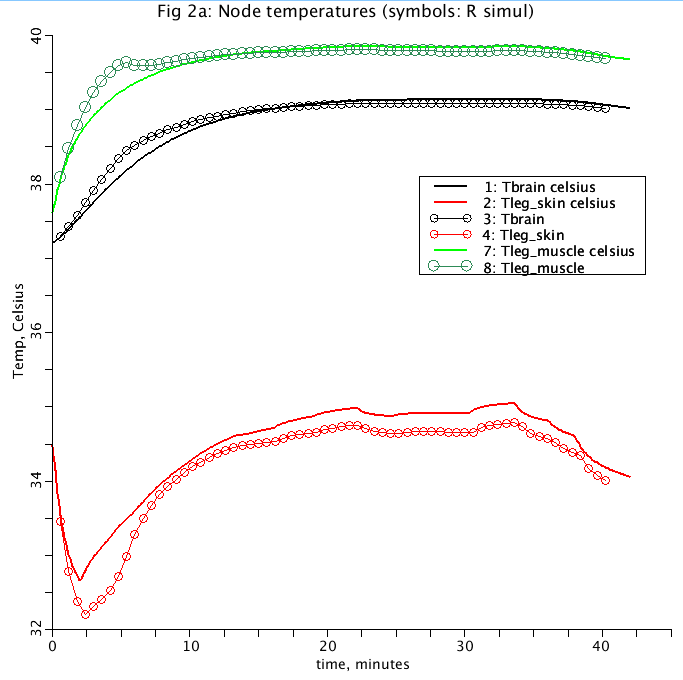Whole body model of human energy conversion and heat transport. Used to simulate a mountain time trial for the Tour de France. Model transposed directly from 'R' model written for van Beek et al., 2011 paper.
Description
(Abstract from van Beek et al., 2011): The human physiological system is stressed to its limits during endurance sports competition events.We describe a whole body computational model for energy conversion during bicycle racing. About 23 per cent of the metabolic energy is used for muscle work, the rest is converted to heat. We calculated heat transfer by conduction and blood flow inside the body, and heat transfer from the skin by radiation, convection and sweat evaporation, resulting in temperature changes in 25 body compartments. We simulated a mountain time trial to Alpe d’Huez during the Tour de France. To approach the time realized by Lance Armstrong in 2004, very high oxygen uptake must be sustained by the simulated cyclist. Temperature was predicted to reach 39C in the brain, and 39.7C in leg muscle. This is a JSim model implimentation of the original 'R' code used in the simulation described in the van Beek et al. 2011 paper. This model includes unit balance in all calculations and attempts to reproduce the 'R' simulation output for the Alpe d'Huez time trial.

Figure: Reproduction of Figure 2a from van Beek et al. 2011 paper. Temperatures in brain, leg muscle, and leg skin of body over the course of cycling time trial. Lines represent JSim model simulation while symbols are from 'R' simulation referenced in 2011 paper.
Equations
The equations for this model may be viewed by running the JSim model applet and clicking on the Source tab at the bottom left of JSim's Run Time graphical user interface. The equations are written in JSim's Mathematical Modeling Language (MML). See the Introduction to MML and the MML Reference Manual. Additional documentation for MML can be found by using the search option at the Physiome home page.
Download R version of model:
- Download JSim model MML code (text):
- Download translated SBML version of model (if available):
We welcome comments and feedback for this model. Please use the button below to send comments:
- (primary) van Beek JH, Supandi F, Gavai AK, de Graaf AA, Binsl TW, Hettling H, Simulating the physiology of athletes during endurance sports events: modelling human energy conversion and metabolism. Philos Transact A Math Phys Eng Sci 2011, 369:4295–4315.
- Stolwijk, J. A. & Hardy, J. D., 1966, Temperature regulation in man – a theoretical study. Pfluegers Arch. Gesamte Physiol. Menschen und der Tiere 291, 129–162. (doi:10.1007/BF00412787)
- Stolwijk, J. A., 1971, A mathematical model of physiological temperature regulation in man. NASA Contractor Report CR-1855, National Aeronautics and Space Administration, Washington, DC.
- Coyle, E. F. 2005 Improved muscular efficiency displayed as Tour de France champion matures. J. Appl. Physiol. 98, 2191–2196. (doi:10.1152/japplphysiol.00216.2005)
- Olds, T. S., Norton, K. I. & Craig, N. P., 1993, Mathematical model of cycling performance. J. Appl. Physiol. 75, 730–737.
- van Beek, J. H. G. M., 2007, Adenine nucleotide-creatine-phosphate module in myocardial metabolic system explains fast phase of dynamic regulation of oxidative phosphorylation, Am. J. Physiol. Cell Physiol. 293, C815–C829. (doi:10.1152/ajpcell.00355)
Please cite https://www.imagwiki.nibib.nih.gov/physiome in any publication for which this software is used and send one reprint to the address given below:
The National Simulation Resource, Director J. B. Bassingthwaighte, Department of Bioengineering, University of Washington, Seattle WA 98195-5061.
Model development and archiving support at https://www.imagwiki.nibib.nih.gov/physiome provided by the following grants: NIH U01HL122199 Analyzing the Cardiac Power Grid, 09/15/2015 - 05/31/2020, NIH/NIBIB BE08407 Software Integration, JSim and SBW 6/1/09-5/31/13; NIH/NHLBI T15 HL88516-01 Modeling for Heart, Lung and Blood: From Cell to Organ, 4/1/07-3/31/11; NSF BES-0506477 Adaptive Multi-Scale Model Simulation, 8/15/05-7/31/08; NIH/NHLBI R01 HL073598 Core 3: 3D Imaging and Computer Modeling of the Respiratory Tract, 9/1/04-8/31/09; as well as prior support from NIH/NCRR P41 RR01243 Simulation Resource in Circulatory Mass Transport and Exchange, 12/1/1980-11/30/01 and NIH/NIBIB R01 EB001973 JSim: A Simulation Analysis Platform, 3/1/02-2/28/07.

